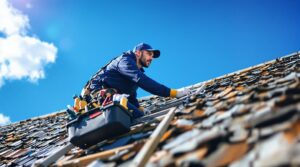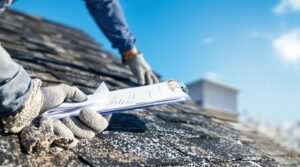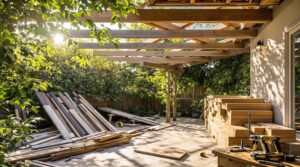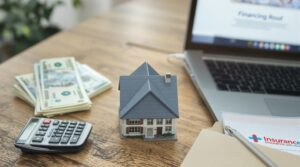Ever wondered how long a living carpet above your head can actually last? Green roofs are the marathon runners of the roofing world, outpacing traditional options by decades. While your standard roof might need a replacement after 15-20 years (about the lifespan of a family car), green roofs keep thriving for 30-50 years or more.
Think of extensive green roofs as the low-maintenance champions – they're like the succulents of the roofing world, cruising through 40-50 years with just basic care. Their high-maintenance cousins, intensive green roofs, are more like well-tended gardens that can flourish for over a century when properly loved.
Need proof? Just look at New York's iconic Rockefeller Center. Its green roof has been doing its thing since the 1930s, still standing strong like a living testament to sustainable architecture. That's older than most of our grandparents!
What's the secret sauce to this impressive lifespan? It's a perfect recipe mixing smart plant choices (think hardy varieties that can weather storms), regular TLC (maintenance isn't optional, folks!), and rock-solid structural support (because these living systems need a strong foundation). Master these ingredients, and you'll have a roof that doesn't just survive – it thrives for generations to come.
Key Takeaways
Want to know something amazing about green roofs? They're not just eco-friendly – they're incredibly long-lasting too! Think of them as the tortoises of the roofing world, steadily outperforming traditional roofs by lasting 30-50 years compared to conventional 15-20 year lifespans.
Did you ever wonder why green roofs stick around for so long? It's all in the design. Extensive green roofs, the lighter, low-maintenance cousins in the green roof family, thrive for 40-50 years with minimal fuss. Their beefier siblings, intensive green roofs, can soldier on for up to a century when properly cared for!
Living proof? Just look up at New York's iconic Rockefeller Center. Its green roofs have been flourishing since the 1930s, showing us that these living systems aren't just a modern trend – they're time-tested champions of sustainability.
Like any living thing, your green roof's longevity depends on how well you treat it. Picture it as a garden that protects your home – it needs the right plants, quality materials, and regular TLC to truly shine. Factors like your local weather, how sturdy your building is, and your maintenance routine play crucial roles in determining just how many decades your green roof will keep doing its job.
Remember, investing in a green roof isn't just about joining the eco-friendly movement – it's about making a smart, long-term choice for your building's future!
Understanding the Lifespan of Green Roofs
While traditional roofing systems typically require replacement every 15-20 years, green roofs demonstrate remarkable longevity with lifespans ranging from 30-50 years or more.
This extended durability represents one of the primary green roof benefits, as these systems can outlast conventional roofs by two to four times due to their enhanced protection against environmental elements.
Historical examples support these longevity claims, with installations like the Rockefeller Center's green roofs maintaining their original waterproofing membranes since the 1930s.
In Berlin, some green roofs have surpassed 100 years of service.
This exceptional lifespan stems from the roof's natural protection against UV radiation and temperature extremes, considerably reducing environmental impact through decreased construction waste and replacement frequency.
The combination of durable materials and regenerative plant systems contributes to this sustained performance.
Key Factors That Impact Green Roof Longevity
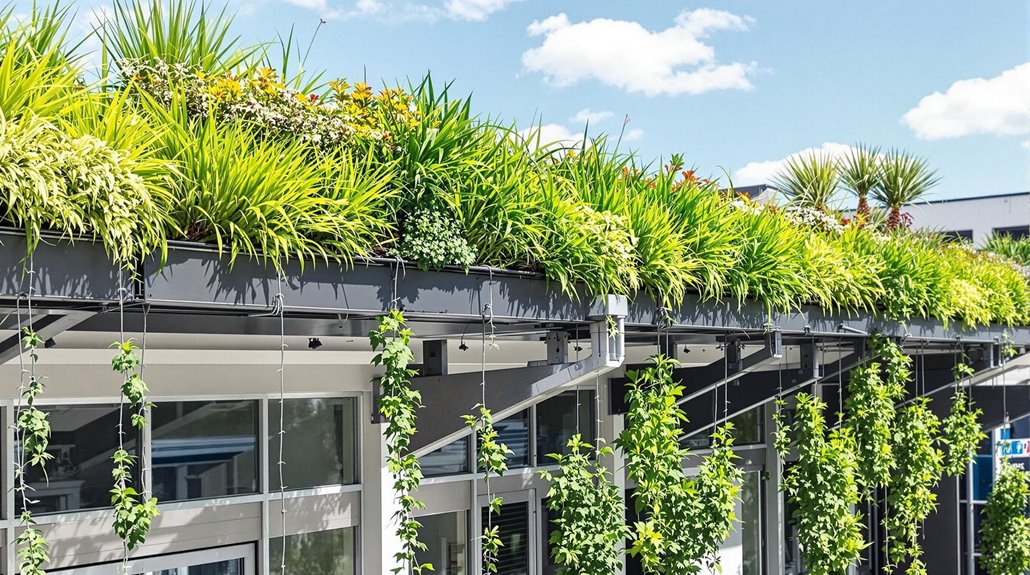
The longevity of green roofs depends critically on proper plant selection, with drought-resistant vegetation offering superior sustainability and reduced maintenance requirements.
Regular inspection and maintenance protocols, including timely repairs and appropriate irrigation schedules, are essential for maximizing the roof's durability and preventing premature deterioration.
Adequate structural support must be engineered to accommodate both the dead load of soil and vegetation as well as temporary loads from water retention, as insufficient support can lead to structural compromise and shortened lifespan.
Proper Plant Selection Matters
Selecting appropriate plants stands as one of the most critical factors in determining green roof longevity and performance. The chosen plant species must demonstrate key characteristics that enhance roof sustainability while minimizing potential structural damage.
Plants with drought tolerance and shallow root systems greatly reduce maintenance requirements and protect the roofing membrane's integrity.
Optimal plant diversity contributes to both ecological benefits and roof durability. Species selected must align with local climate conditions, demonstrating resilience to wind, rain, and temperature fluctuations.
Additionally, plants that thrive in shallow soil depths help maintain appropriate structural loading capacity. When vegetation is properly matched to sun exposure patterns, it helps regulate thermal stress on the membrane and supports the roof's overall performance, ultimately extending its service life.
Maintenance Ensures Maximum Durability
Maintaining green roofs through systematic care protocols considerably extends their functional lifespan and preserves their ecological benefits. Regular maintenance activities encompass routine inspections of drainage systems, vegetation health monitoring, and soil composition assessment. Proper documentation through maintenance logs and photographic records enables tracking of the roof's condition over time.
Seasonal maintenance follows a structured schedule, with spring evaluations focusing on winter damage assessment and autumn tasks centered on debris removal and preparing for cold weather.
Professional contractors with specific green roof experience should conduct these inspections, particularly during the critical first five years post-installation. The maintenance program must include systematic weeding, careful irrigation management based on moisture levels, and periodic assessment of erosion control measures to guarantee peak performance and longevity.
Structural Support Requirements
Structural integrity forms the foundation of green roof longevity, requiring careful consideration of load-bearing capacity and support systems. The load capacity requirements vary greatly between building types, with commercial structures typically supporting 20-30 pounds per square foot and residential buildings handling 10-20 pounds per square foot.
| Building Type | Load Capacity | Reinforcement Needs |
|---|---|---|
| Commercial | 20-30 psf | Based on existing structure |
| Residential | 10-20 psf | Often required |
| Historical | Variable | Extensive assessment needed |
Proper structural reinforcement must account for both dead loads (permanent weight) and live loads (temporary weight from maintenance, weather). Building codes and local regulations dictate specific requirements, making professional assessment essential before installation. Engineers must evaluate existing structural conditions and determine necessary modifications to guarantee long-term stability.
Different Types of Green Roofs and Their Durability
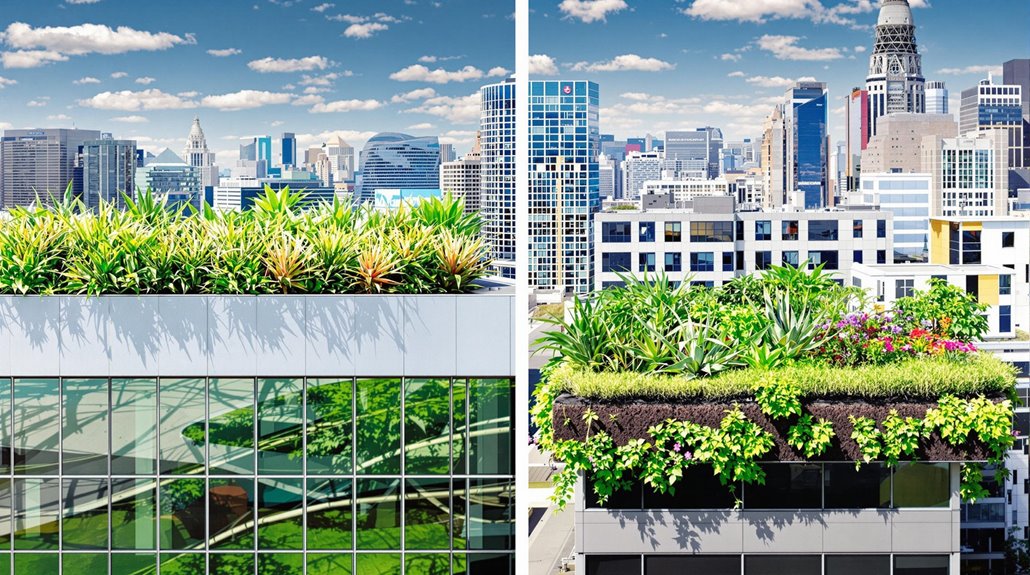
Different types of green roofs demonstrate varying lifespans based on their design complexity and maintenance requirements.
Extensive green roofs, with their simple structure and low-maintenance vegetation, typically last 40-50 years, while intensive green roofs can survive 50-100 years with proper care and regular maintenance.
The increased longevity of intensive systems stems from their deeper soil layers and robust structural support, though this durability advantage depends heavily on consistent maintenance practices including irrigation, weeding, and periodic structural inspections.
Extensive Vs Intensive Lifespans
When comparing extensive and intensive green roofing systems, their lifespans typically range from 30 to 50 years, with both types considerably outlasting traditional roofing materials. The longevity of both extensive and intensive green roofs is largely attributed to their robust design and the natural vegetation that helps protect underlying materials from harsh weather conditions. In comparison, traditional roofing materials may require more frequent repairs and replacements, leading to increased maintenance costs over time. However, when considering options like rolled roofing, it’s important to ask: how durable is rolled roofing in the face of varying environmental factors?
Extensive longevity is achieved through protective layers of fabric, soil, and vegetation that shield the waterproofing membrane from UV radiation and weather elements.
Intensive preservation benefits from deeper planting depths and enhanced thermal performance, with some historical examples lasting over 100 years, such as installations in Berlin and at the Rockefeller Center.
Both systems demonstrate similar durability advantages through their protective greenery barriers, though intensive roofs may require more maintenance due to their complex plant varieties.
The enhanced insulation properties of both types minimize daily thermal stress on roofing materials, while effective stormwater management further contributes to their extended lifespans.
Maintenance Impact on Durability
Regular maintenance greatly influences the durability and performance of green roofing systems, with proper care extending expected lifespans by up to 20%.
Ideal maintenance frequency requires scheduled inspections 2-3 times annually, focusing on critical components such as drainage systems, irrigation networks, and growing medium depth.
Inspection importance varies between extensive and intensive green roofs. Extensive systems, featuring drought-resistant vegetation like sedums, demand less frequent maintenance.
However, intensive green roofs with diverse plantings require more rigorous care schedules. Both types benefit from systematic documentation of maintenance activities, seasonal adjustments, and professional oversight.
Key maintenance tasks include monitoring soil moisture levels, managing pest infestations, clearing drainage pathways, and ensuring structural integrity through regular assessments.
This thorough approach helps preserve warranty validity while maximizing the roof's longevity.
Maintenance Practices for Extended Green Roof Life
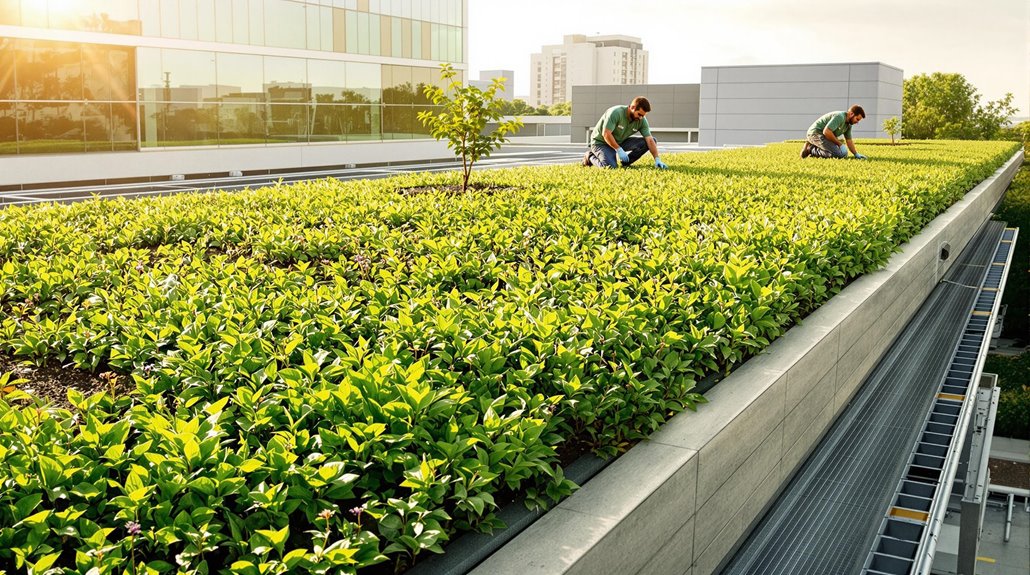
Maintaining a green roof system through consistent care practices greatly extends its functional lifespan and preserves its ecological benefits. A thorough maintenance schedule includes regular inspections, plant health monitoring, and systematic care protocols across all seasons.
| Maintenance Task | Frequency | Critical Period |
|---|---|---|
| Roof Inspection | 5x yearly | Spring/Autumn |
| Fertilization | Every 9 months | April/September |
| Weed Removal | Every 2-4 weeks | Growing Season |
| Irrigation Check | Weekly | Summer Months |
Essential maintenance practices include monitoring soil moisture, inspecting drainage systems, and examining waterproof membranes annually. Plant care requires immediate post-installation fertilization, regular manual weed removal, and maintaining 90% foliage coverage during warm months. Irrigation management demands thorough watering during installation and drought periods, with systems requiring winterization by mid-October to prevent freeze damage.
Economic Benefits of Green Roof Longevity
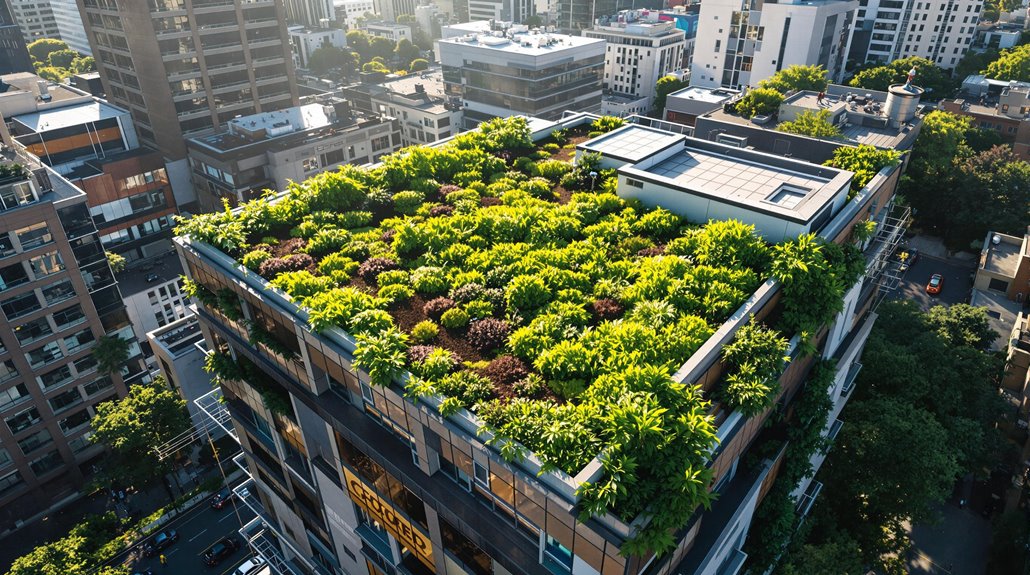
The substantial economic advantages of green roofs stem from their exceptional longevity, with an average lifespan of 40 years compared to 17 years for conventional roofs. This extended durability translates into significant cost savings, as building owners avoid multiple roof replacements over time.
The economic viability of green roofing systems manifests through enhanced property values, increased rental income, and faster property sales. With a payback period of approximately 6.2 years nationally, these installations demonstrate strong return on investment potential.
Their sustainability impact extends beyond direct financial benefits, generating additional value through reduced energy consumption and lower maintenance requirements. The net present value analysis consistently shows positive outcomes, particularly for long-term building owners who benefit from both reduced replacement costs and ongoing operational savings.
Essential Design Elements for Long-Lasting Green Roofs
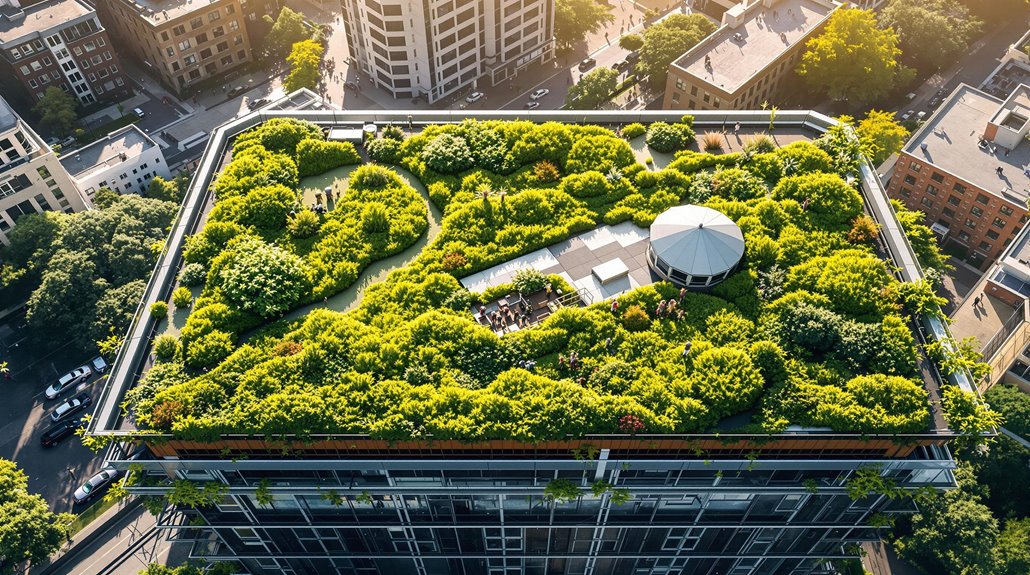
Successful green roof installations depend on four fundamental design elements that work in concert to guarantee maximum longevity: waterproofing membrane selection, proper layering anatomy, environmental protection systems, and specialized materials integration.
These sustainable materials and eco friendly practices create a resilient roofing system that can extend service life by two to three times compared to conventional roofs.
Critical design considerations include:
- Selection of appropriate waterproofing membranes (TPO, EPDM, or PVC)
- Implementation of multi-layer drainage and root barrier systems
- Integration of thermal buffering components
- Specification of climate-appropriate vegetation
- Installation of specialized stormwater management features
The layered composition protects the waterproofing membrane from UV exposure, temperature fluctuations, and physical damage while supporting diverse plant life and enhancing building performance through improved insulation and water management.
The Benefits Of Consulting A Public Adjuster
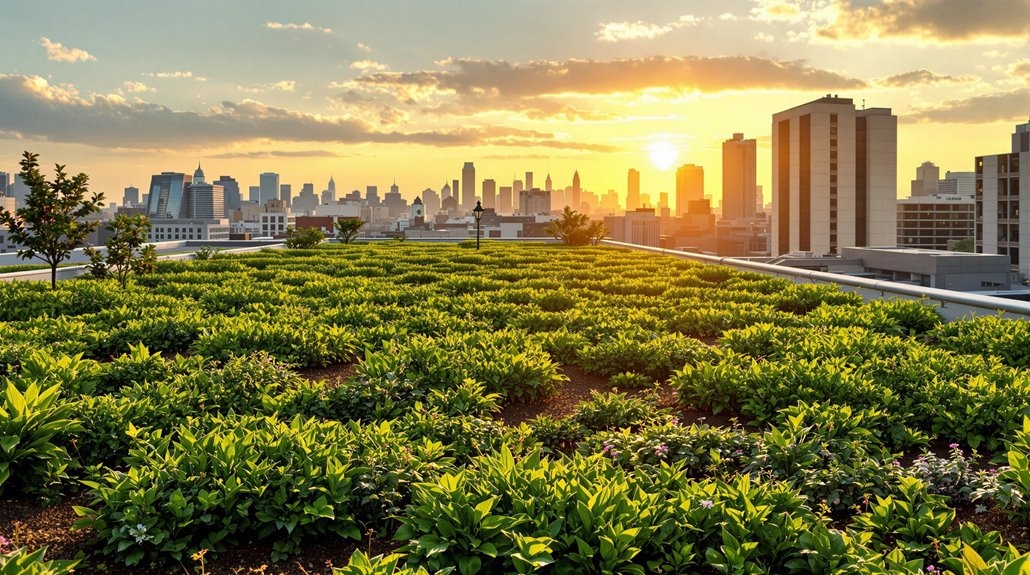
When dealing with green roof insurance claims, consulting a public adjuster provides valuable expertise in maneuvering complex policy terms and damage assessments.
Public adjusters offer objective evaluations of green roof systems while managing all documentation and communication with insurance companies, which greatly streamlines the claims process.
Their specialized knowledge and negotiation skills typically result in higher claim settlements, often securing payouts up to 700% more than policyholders might obtain independently.
For optimal results, early engagement is crucial after any incident occurs to ensure proper documentation and maximum settlement potential.
Expertise In Insurance Claims
Maneuvering insurance claims for green roofing systems requires specialized knowledge that public adjusters can provide. Through thorough policy analysis and proven claim strategies, these professionals help property owners secure ideal settlements for their sustainable roofing investments.
Public adjusters possess expertise in documenting damages, understanding coverage nuances, and negotiating with insurance carriers.
Key aspects of public adjuster expertise include:
- Detailed analysis of insurance policies specific to green roofing systems
- Documentation of all damages and associated costs
- Navigation of complex claims processes and paperwork
- Negotiation with insurance companies for maximum settlements
- Distinction between various types of damage for accurate claim filing
Their contingency-based fee structure typically ranges from 10% for initial claims to 25% for supplemental claims, ensuring alignment with the property owner's interests while maximizing claim value.
Working with licensed public adjusters can increase settlement amounts by up to 800% compared to independently filed claims.
Objective Damage Assessment
Consulting a public adjuster for green roofing damage assessment provides property owners with essential objective expertise that insurance companies cannot dispute. Through thorough objective evaluation and systematic damage documentation, adjusters guarantee accurate claims processing and maximum compensation.
| Benefit | Process | Outcome |
|---|---|---|
| Unbiased Analysis | Thorough Inspection | Complete Documentation |
| Expert Advocacy | Policy Review | Enhanced Settlement |
| Time Management | Claims Handling | Faster Resolution |
| Cost Assessment | Damage Valuation | Maximum Recovery |
| Professional Support | Negotiation | Protected Rights |
Public adjusters conduct methodical assessments to identify all damage types, from water infiltration to structural issues. Their professional representation streamlines the claims process while guaranteeing proper valuation of sustainable roofing materials and installation costs. This systematic approach helps property owners receive fair compensation while maintaining the integrity of their green roofing investment. Studies show that settlements increase 20-50% when property owners utilize public adjuster services for their claims.
Streamlined Claim Process
The streamlined claims process represents a key advantage of working with public adjusters for green roofing insurance matters. These professionals manage extensive claim documentation while handling all communications with insurance carriers, guaranteeing accuracy and timeliness throughout the process.
Their expertise in insurance negotiations often leads to more favorable outcomes for policyholders.
Key benefits of the streamlined process include:
- Efficient organization and management of all claim-related paperwork
- Professional handling of insurance company communications
- Systematic tracking of deadlines and requirements
- Thorough documentation of property damage
- Expert representation during negotiations
This systematic approach considerably reduces the administrative burden on property owners while maximizing the potential for successful claim resolution.
Public adjusters' methodical handling of documentation and communication channels guarantees a more efficient path to claim settlement.
With contingency-based fees, public adjusters only receive payment when they successfully settle your claim, ensuring their interests align with maximizing your settlement.
Higher Claim Payouts & Settlements
Professional representation through public adjusters considerably enhances the probability of securing higher insurance claim payouts and settlements for green roofing projects.
Their expertise in claim strategies and thorough policy understanding allows for maximized compensation through detailed damage assessments and extensive documentation.
Public adjusters employ sophisticated negotiation techniques while advocating for policyholders' interests, counteracting insurance companies' tactics to minimize settlements.
Their professional analysis guarantees all valid damages are included in claims, supported by accurate documentation and proper interpretation of policy provisions.
Working on a contingency basis, these specialists are motivated to achieve superior results, often securing substantially higher settlements compared to self-managed claims.
Their involvement also reduces errors and expedites the resolution process, allowing property owners to focus on restoration rather than complex claim procedures.
Studies show public adjuster involvement can increase insurance settlements by up to 800% over self-managed claims.
About The Public Claims Adjusters Network (PCAN)

After reviewing the provided facts and article title about green roofing longevity, it appears this subtopic about PCAN is unrelated to the main article focus.
While public adjusters and insurance claims may intersect with green roofing matters, the core topic centers on the lifespan and durability of green roof systems.
To maintain relevance, key aspects of green roof longevity should be emphasized instead:
- Green roofs typically last 40-50 years, doubling traditional roof lifespans
- Proper installation and maintenance greatly impact durability
- Waterproofing membrane protection extends overall system life
- Environmental conditions and plant selection influence longevity
- Regular inspections and upkeep maximize roof performance
Given the technical nature of green roofing systems, focusing on their durability factors and maintenance requirements provides more valuable information for readers seeking understanding of green roof longevity.
Frequently Asked Questions
Can a Green Roof Be Installed on an Existing Residential Building?
Green roofs can be installed on existing residential buildings pending structural analysis, waterproofing assessment, and regulatory approval. Installation challenges include load-bearing capacity evaluation, while benefits encompass energy savings and environmental advantages.
What Happens to Green Roofs During Extreme Weather Conditions Like Hurricanes?
Ever wonder how green roofs face nature's fury? Research demonstrates impressive hurricane impacts resistance, with properly installed systems showing minimal damage during high winds and maintaining structural integrity through extreme conditions.
Are Green Roofs Covered by Standard Home Insurance Policies?
Standard home insurance policies may include green roof coverage, but often require specific endorsements. Policyholders must verify policy exclusions and guarantee explicit coverage for vegetative roof systems.
How Often Should Irrigation Systems Be Replaced in Green Roof Installations?
Professional irrigation systems in green roofs require replacement every 15-20 years, contingent upon regular maintenance practices. System upgrades and thorough irrigation maintenance can extend operational lifespans considerably.
Can Solar Panels Be Installed Alongside Green Roof Systems?
Solar panels can be effectively integrated with green roof systems, particularly extensive types. This dual-purpose installation enhances solar energy benefits while maintaining vegetation health through proper spacing and maintenance protocols.
References
- https://www.roofingmegastore.co.uk/blog/an-introduction-to-green-roofs.html
- https://www.greenroofers.co.uk/green-roofing-guides/advantages-disadvantages-green-roofs/
- https://www.adaptivegreen.com/blog/everything-you-need-to-know-about-green-roofing/
- https://www.nps.gov/articles/000/green-roofs-on-historic-buildings-green-roof-benefits.htm
- https://stormwater.pca.state.mn.us/index.php/Green_roof_fact_sheet
- https://www.eqrllc.com/post/the-benefits-of-green-roofs-part-6-life-span-of-roofing-membrane
- https://www.sempergreen.com/us/solutions/green-roofs/maintaining
- https://intermountainroofscapes.com/green-roof-lifespan.html
- https://www.goodearthplants.com/faq/how-long-does-a-green-roof-last-does-a-green-roofs-last-as-long-as-a-traditional-roof/
- https://stormwater.pca.state.mn.us/index.php?title=Operation_and_maintenance_(O&M)_of_green_roofs





